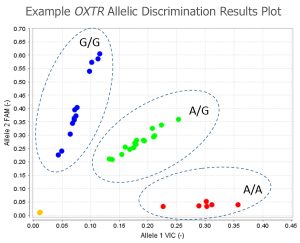Drop Date: March 2016
SBB – Oxytocin Receptor Genotyping From Saliva
In This Drop: Salivary DNA + OXTR = Great Research
 Studies of the Oxytocin Receptor Gene (OXTR) have provided critical information about the downstream effects of oxytocin on a variety of behaviors including stress, anxiety, social memory, sexual and aggressive behavior, bonding, and maternal behavior (1). The OXTR protein is part of the G-protein coupled receptor family, and is expressed in the mammary glands, uterus, and central nervous system (2). Research studies surveying behavioral associations with multiple Single Nucleotide Polymorphisms (SNPs) in the Oxytocin Receptor Gene have found links to individual differences in emotional regulation, personality traits, and social behaviors (3-7).
Studies of the Oxytocin Receptor Gene (OXTR) have provided critical information about the downstream effects of oxytocin on a variety of behaviors including stress, anxiety, social memory, sexual and aggressive behavior, bonding, and maternal behavior (1). The OXTR protein is part of the G-protein coupled receptor family, and is expressed in the mammary glands, uterus, and central nervous system (2). Research studies surveying behavioral associations with multiple Single Nucleotide Polymorphisms (SNPs) in the Oxytocin Receptor Gene have found links to individual differences in emotional regulation, personality traits, and social behaviors (3-7).
Three possible genetic variants exist for the most commonly studied oxytocin receptor polymorphism rs53576: A/G, A/A or G/G. Results from one study showed that individuals homozygous for the G allele of rs53576 (G/G) exhibited higher behavioral and dispositional empathy. The same study also showed that individuals with one or two copies of the A allele possess lower levels of optimism, mastery, parenting skills, and self-esteem, when compared to those with the G/G allele (8, 9). Interestingly, Bradley et al. demonstrated rs53576 G/G allele carriers who were severely maltreated during childhood showed enhanced levels of emotional dysregulation in adulthood when compared to A/A or A/G carriers (4). Consistent with these behavioral associations for the OXTR SNP rs53576, multiple other SNPs within OXTR have also been shown to have an impact on behavioral traits in several studies (10).
High quality salivary DNA is easily available without the need for expensive specialized collection devices. With Salimetrics’ DNA extraction protocol and greater than 99% call rate or genotype assignment, you can expand your data set to draw better conclusions by simply adding DNA analysis to your study design.
REFERENCES & RELATED RESEARCH
- Lee, H.J. et al (2009). Oxytocin: the great facilitator of life.. Prog Neurobiol, 88(2), 127-51.
- Aspé-Sánchez, M. et al (2015). Oxytocin and Vasopressin Receptor Gene Polymorphisms: Role in Social and Psychiatric Traits. Front Neurosci, 9:510, eCollection.
- Ng, P.K. et al (2004). Effect of storage conditions on the extraction of PCR-quality DNA from saliva. Clinica Chimica Acta, 343(2004), 191-194.
- Bradley, B. et al (2011). Association between childhood maltreatment and adult emotional dysregulation in low-income, urban, African American sample: Moderation by ox. Development and Psychopathology, 23(2011), 439-452.
- Behnia, F. et al (2015). Fetal DNA methylation of autism spectrum disorders candidate genes: association with spontaneous preterm birth. American Journal of Obstetrics & Gynecology, 212(4), 533.e1–533.e9.
- Myers, A. et al (2014). Variation in the oxytocin receptor gene is associated with increased risk for anxiety, stress, and depression in individuals with a history . Journal of Psychiatric Research, 59(2014), 93-100.
- Davis, MC. et al (2014). Associations Between Oxytocin receptor genotypes and social cognitive performance in individuals with schizophrenia. Official Journal of the Schizophrenia Institutional Research Society, 159(2-3), 353-357.
- Spahire-Bernstein, S. et al (2011). Oxytocin receptor gene (OXTR) is related to psychological resources. PNAS, 108(37), 15118–15122.
- Rodrigues, S. et al (2009). Oxytocin receptor genetic variation relates to empathy and stress reactivity in humans. PNAS, 106(50), 21437-21441.
- Tost, H. et al (2010). A common allele in the oxytocin receptor gene (OXTR) impacts prosocial temperament and human hypothalamic-limbic structure and function. PNAS, 107(31), 13936-41.
*Note: Salimetrics provides this information for research use only (RUO). Information is not provided to promote off-label use of medical devices. Please consult the full-text article.
 Contact: Salimetrics (USA)
Contact: Salimetrics (USA)